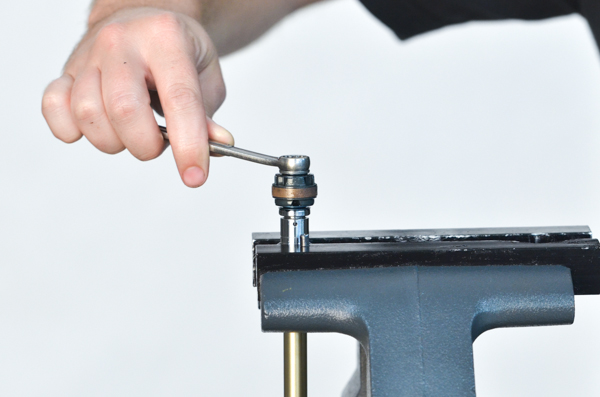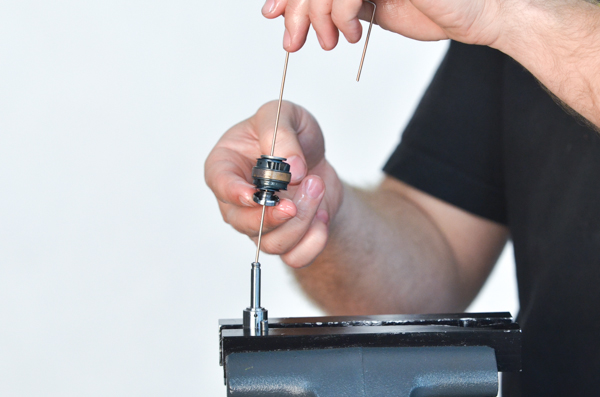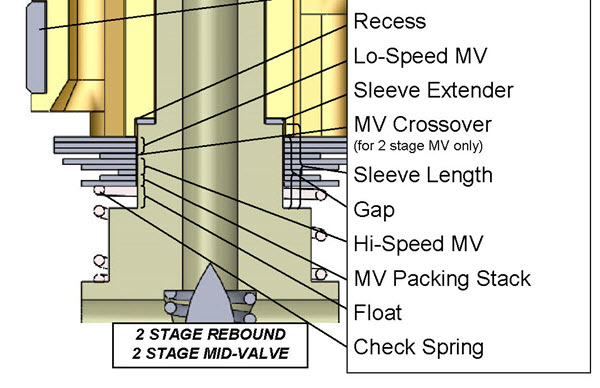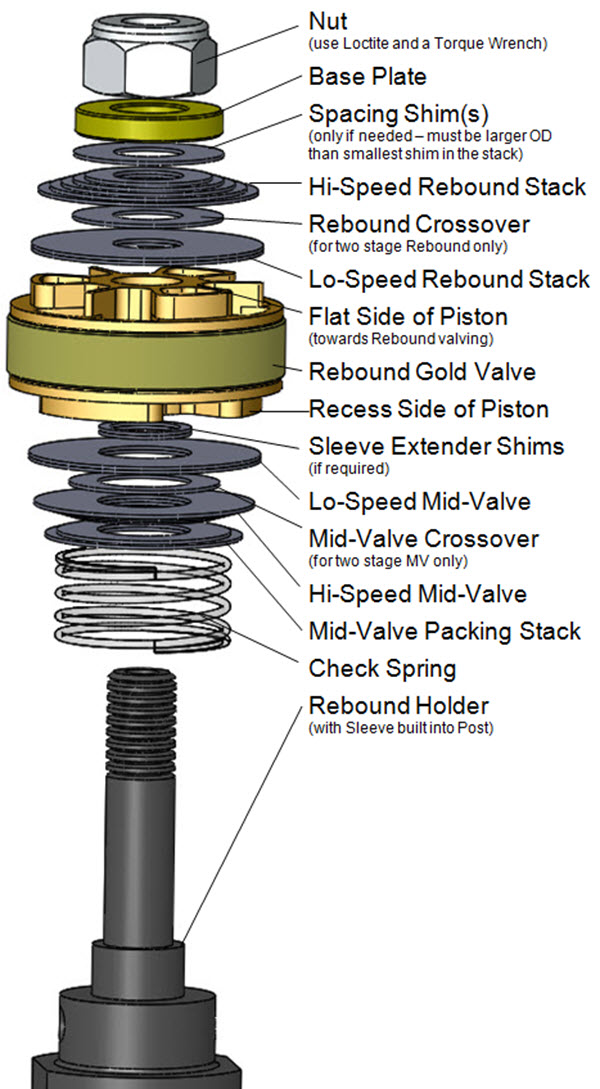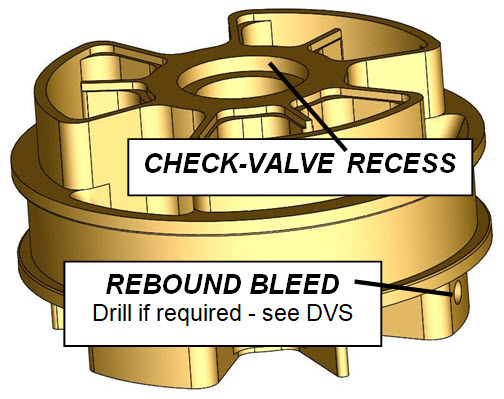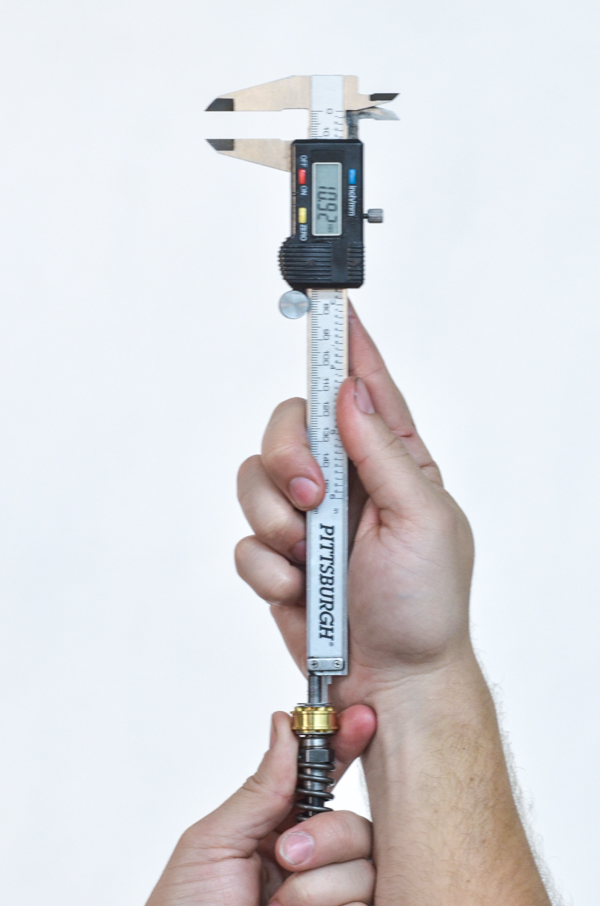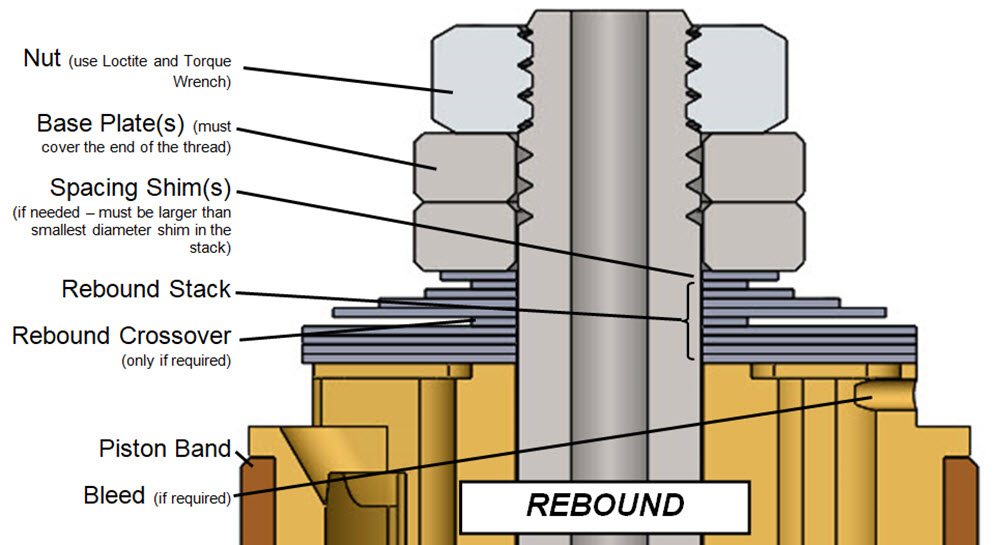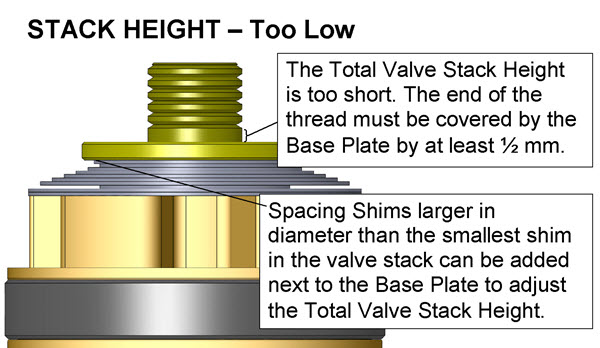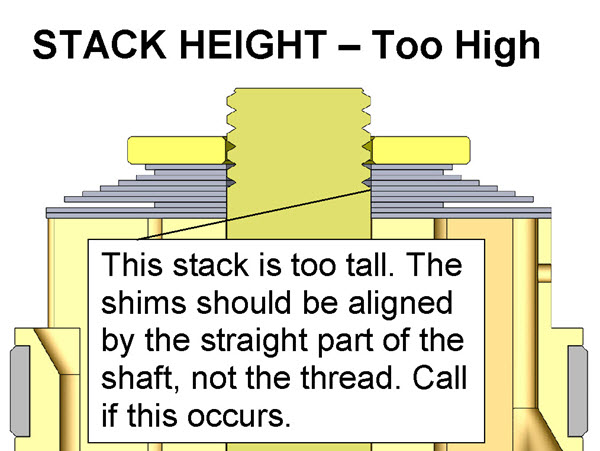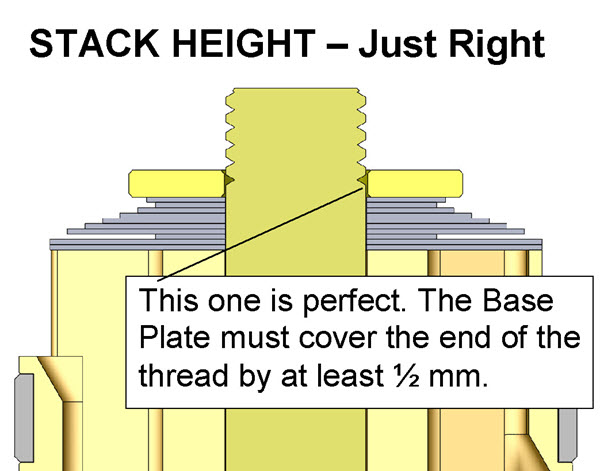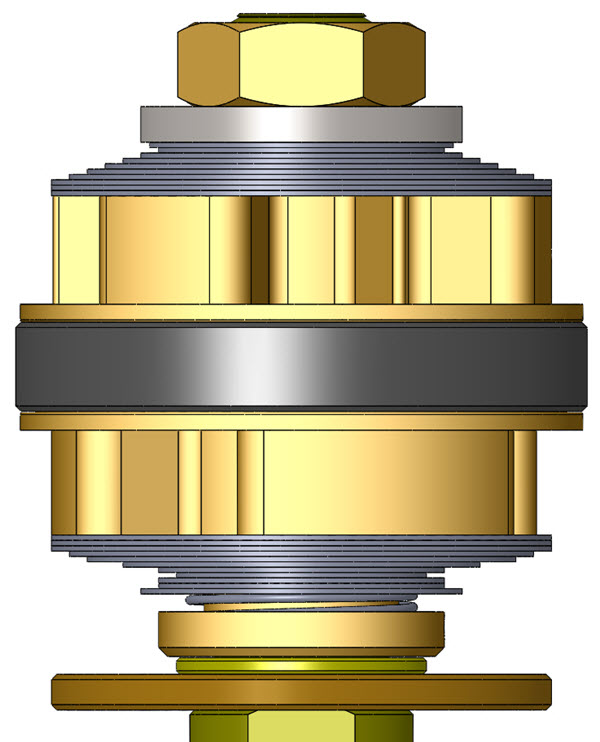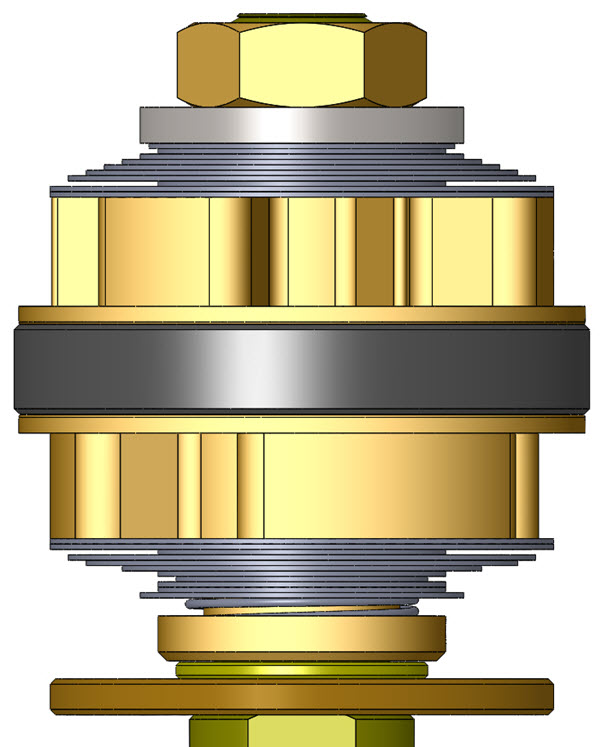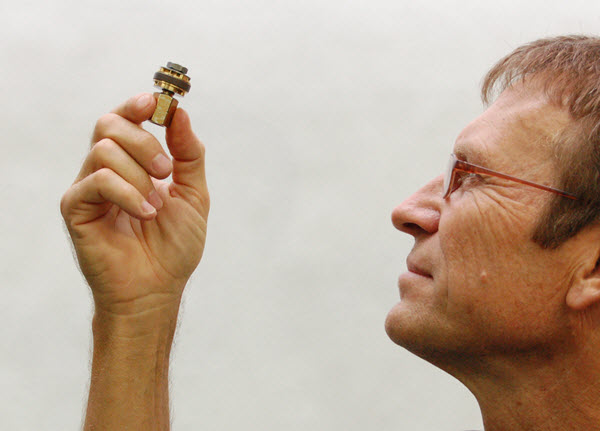FORK REBOUND and MID-VALVE
|
|||||||
|
|
Tools Required
- In-lb torque wrench that accurately measures 0 to 50 in-lbs (0.58 kgf-m) (SnapOn Digital Torque Wrench shown)
- Hi-Strength Loctite (included)
- Metric calipers and micrometer
|
||||||
|
|
VR1- Put the rebound rod in the shaft holding tool and remove the peening by filing it down to the nut face.
This step is not required on WP and Ohlins.
|
||||||
|
|
VR2- Remove the rebound valving nut.
|
||||||
|
|
VR3- Remove the rebound valving assembly.
|
||||||
|
|
VR4- If the end of the shaft was peened over, chamfer the rebound valving shaft lightly. Use a wire wheel on the shaft end to smooth it.
|
||||||
|
|
VR5- Blow air through one of the side holes while covering up the other side hole. This allows any fillings that may be in the shaft to be removed through the top hole.
This model Rebound Holder does not look like this but you get the idea.
|
||||||
|
VALVING STACK TYPES - SINGLE OR TWO STAGE
VR6- You will either be building a Single Stage or a Two Stage Stack for both the Mid-Valve and the Rebound Stacks. The difference is the Crossover. The Crossover is a smaller diameter shim between the Lo-Speed and the Hi-Speed Stacks. THIS IS DISPLAYED SHIM BY SHIM IN THE DVS. Note that the DVS might call for a Single Stage Mid-Valve Stack and a Two Stage Rebound Stack (or the other way around). Note: The DVS Custom Setup Sheet displays individual shims and does not label Hi-Speed, Crossover, and Lo-Speed. This is for your information only. Also YOU WILL NOT USE ALL the shims provided in the Kit.
|
|||||||
|
|
VR7- MID-VALVE STACK
Install the Check Spring.
Assemble the Mid-Valve Stack recommended by the DVS onto the Valving Shaft.
Note that on the DVS Setup Sheet it is listed from the piston face. This means it is in reverse order of assembly.
Note - there may be Sleeve Extender Shims (6 id x 8 od).
Float is the amount the Mid-Valve stack moves before it has to bend.
Once the complete assembly is built, check the Float with a feeler gauge (step VR14). This may be off due to production tolerances. See step VR14 for adjustment details.
|
||||||
|
|
VR8- REBOUND BLEED HOLE
If the DVS does not call for a Rebound Bleed Hole skip this step.
If your DVS Setup Sheet calls for a Rebound Bleed Hole check to see if there is one already pre-drilled in the piston. If one is called for, and there is no pre- drilled bleed hole, you will need to drill one.
Notice that the bleed hole is on the opposite side of the piston with the Recess and is drilled sideways. It connects the two sides of the piston and bypasses the valving stack. The exact location is not critical.
|
||||||
|
|
|||||||
|
|
VR10- REBOUND STACK
Install the DVS recommended Rebound Stack with the largest shim of the Lo-Speed Stack first against the piston face. Make sure the shims completely cover the ports.
If a two stage rebound stack is called for in the DVS, install the Rebound Crossover.
Install the Hi-Speed Rebound Stack in the order listed starting with the largest diameter shim and ending with the smallest diameter shim.
|
||||||
|
|
VR11- Two Stage Rebound Example
(Single Stage is exactly the same except there is no Crossover) For Two Stage the total valving stack is made up of a:
Lo-Speed Stack
Crossover and a
Hi-Speed Stack
(this is only an example - not your setting)
The Total Rebound Valving Stack starting from the Gold Valve piston face:
(4) .15x21 - Lo- Speed Stack
(1) .10x11 - Crossover (notice the smaller diameter)
(1) .10x21 - Hi- Speed Stack
(1) .10x20
(1) .10x18
(1) .10x16
(1) .10x14
(1) .10x12 (1) .10x11
Note: Keep in mind that this is an example only. This valving stack only shows the orientation of the components and the direction of the stack tapers.
|
||||||
|
|
VR12- Make sure the Total Valving Stack Height is correct. Critical!!
This step is here to insure you don't "run out of thread" onto the straight, non-threaded, portion of the shaft when tightening the Nut and the Nut gets full engagement.
The shims should be guided with the straight, non-threaded part of the shaft and should not be on the thread. The Rebound Base Plate should cover or "straddle" the end of the thread.
If needed, height adjustment is done with Spacing Shims added just below the Reboud Base Plate.
Spacing Shims must be larger in diameter than the smallest shim in the stack. Sometimes this is best accomplished by adding additional Base Plates.
|
||||||
|
|
VR13- TIGHTEN THE COMPLETE ASSEMBLY
Make sure there is Loctite on the thread of the shaft. Make sure the mid-valve is free to move up and down. Tighten it to spec with a torque wrench.
CAUTION! The threads can be damaged without extreme care. You must use Loctite.Most 6mm bolts must be torqued with a torque wrench to 30 in-lbs (2.5 ft-lbs or 0.35 kgf-m), NO MORE!8mm bolts must be torqued with a torque wrench to 45 in-lbs (3.8 ft-lbs or 0.52 kgf-m), NO MORE! Check your DVS Setup Sheet. Do not take this step lightly. |
||||||
|
|
VR14- CHECK THE FLOAT
(if you would like more detail about float click here) Float is the amount the stack moves before it has to bend.
FLOAT is the most critical valving setup in the entire front fork. Use a feeler gauge to measure the actual "float" of the mid- valve.
Insert the feeler gauge between the Gold Valve Piston face and the first shim. Make sure the feeler gauge goes all the way in to the surface of the inner sleeve.
This is the best way to check the float as there are always production tolerances that will throw the predicted float off of the calculated number.
Adjust the Sleeve Extender or Packing Stack (the last shims closest to the Check Spring) to get the correct float. THIS IS CRITICAL!
|
||||||
| VR15- Single Stage Rebound and Single Stage Mid-Valve |
VR15- Two Stage Rebound and Two Stage Mid-Valve |
||||||
|
|
VR16- Check your work. Hold the valve assembly up to the light and look for proper assembly. If there are any problems, disassemble the stack and look for burrs to surface and/or dirt in the valving. Reassemble and check again.
|
||||||
|
|
VR17- Make sure the shims that go next to the Gold Valve completely cover the ports on both sides of the piston! If the ports are not covered there will not be enough damping.
This could be caused by a number of reasons. Please call Tech Support if this occurs.
|
||||||
|
VR18- Continue with installation of the Compression Gold Valve and fork assembly.
|
|||||||
| • Single Stage - made of: Lo-Speed Stack Hi-Speed StackThere is NO Crossover (it becomes one stack.) |
 |
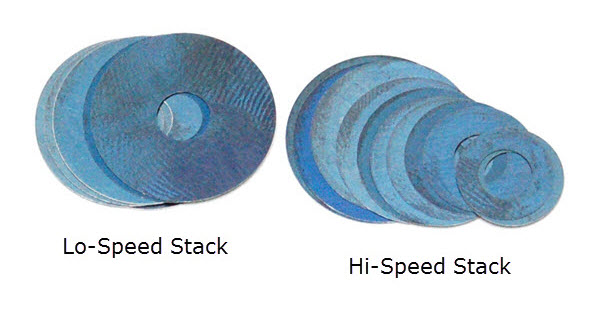 |
| • Two Stage - made of: Lo-Speed Stack Crossover Hi-Speed StackThe Crossover Gap is visible |
 |
 |



